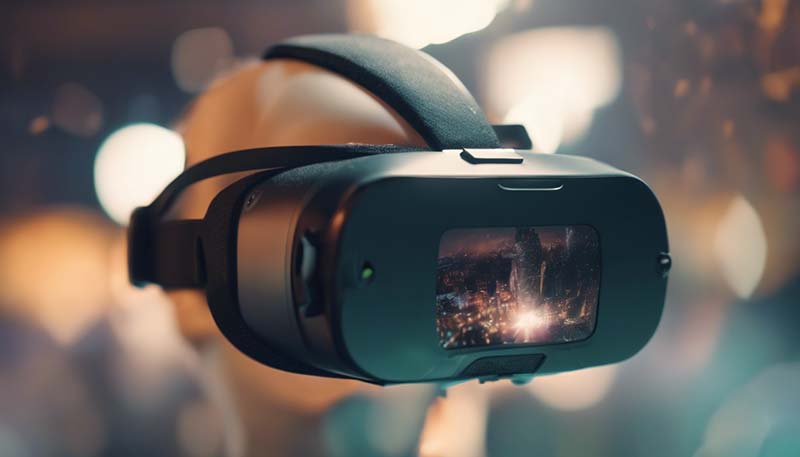The Role of Virtual Reality in Mixed Reality
Virtual Reality (VR) and Mixed Reality (MR) are two distinct but interconnected technologies that are shaping the future of computing, gaming, and communication. While VR is a fully immersive experience that replaces the user's environment with a simulated one, MR combines the real and virtual worlds to create a single, interactive ecosystem. This article explores the role of VR in the development and implementation of MR technologies, highlighting the synergies and challenges that arise from their convergence.
Understanding the Differences and Similarities
Before diving into the role of VR in MR, it's essential to understand the differences and similarities between the two technologies:
- Virtual Reality (VR): VR is a computer-generated environment that simulates a realistic, 3D world. Users wear a headset that blocks out the real world and replaces it with a virtual one. Interactions are primarily through hand controllers or motion sensors.
- Mixed Reality (MR): MR, on the other hand, blends the real and virtual worlds by projecting virtual objects into the user's environment. This is achieved through MR headsets or glasses that allow users to see and interact with both real and virtual objects simultaneously.
Despite their differences, both VR and MR share some commonalities:
- They both use headsets with displays to create immersive experiences.
- They rely on advanced sensors and tracking systems to accurately map the user's movements and interactions.
- Both technologies have applications in gaming, education, training, and various professional fields.
The Role of VR in MR Development
The development of MR has been significantly influenced by advancements in VR technology. Here's how VR plays a role in the evolution of MR:
1. Technological Building Blocks
VR technology serves as a foundation for MR development. The headsets, tracking systems, and controllers used in VR have been adapted and improved to create more sophisticated MR experiences. For example, MR headsets often have more advanced sensors that allow for precise tracking of the user's position and movements in a real-world environment.
2. Content Creation and Design
The content created for VR can be adapted and expanded for MR. VR developers have already explored various storytelling techniques, game mechanics, and interactive design principles that can be applied to MR. This helps MR developers build on existing knowledge and accelerate the creation of engaging MR experiences.
3. User Experience (UX) and Interface Design
VR has provided valuable insights into how users interact with immersive environments. MR developers can leverage these insights to design more intuitive and user-friendly interfaces. For instance, understanding how users navigate in a VR space can inform the design of MR applications that require users to move between real and virtual objects.
4. Market and Consumer Education

The popularity of VR has helped to educate consumers about the potential of immersive technologies. As MR emerges as a distinct category, it benefits from the awareness and interest generated by VR. This makes it easier for MR developers to market their products and for consumers to understand the value proposition of MR experiences.
Challenges and Opportunities
The convergence of VR and MR also presents challenges and opportunities:
1. Technical Challenges
One of the main challenges is ensuring seamless interaction between the real and virtual worlds. This requires advanced spatial awareness, accurate object recognition, and real-time rendering capabilities. MR systems must also be able to adapt to various real-world environments, which can be more complex and unpredictable than controlled VR settings.
2. Content Integration
Integrating virtual content into the real world in a way that feels natural and intuitive is another challenge. MR experiences must be designed to complement the user's environment without causing distraction or confusion. This requires a deep understanding of user behavior and preferences, as well as the ability to create content that is both engaging and contextually relevant.
3. Privacy and Security
MR raises new privacy and security concerns, as it involves capturing and processing real-world data. Developers must ensure that user data is protected and that the technology is not misused. This includes implementing robust security measures and being transparent about how data is collected, stored, and used.
4. Opportunities for Innovation
The challenges also present opportunities for innovation. For example, the need for more advanced tracking and rendering technologies could drive the development of new hardware and software solutions. The potential applications of MR in various fields, from healthcare to architecture, also offer opportunities for creative and impactful solutions.
Conclusion
Virtual Reality has played a significant role in the development of Mixed Reality, providing the technological foundation, design principles, and market awareness needed for MR to flourish. As MR technology continues to evolve, it will likely build upon the successes and learnings of VR while addressing its unique challenges and opportunities. The convergence of VR and MR holds great promise for creating more immersive, interactive, and meaningful experiences that bridge the gap between the digital and physical worlds.
Comment